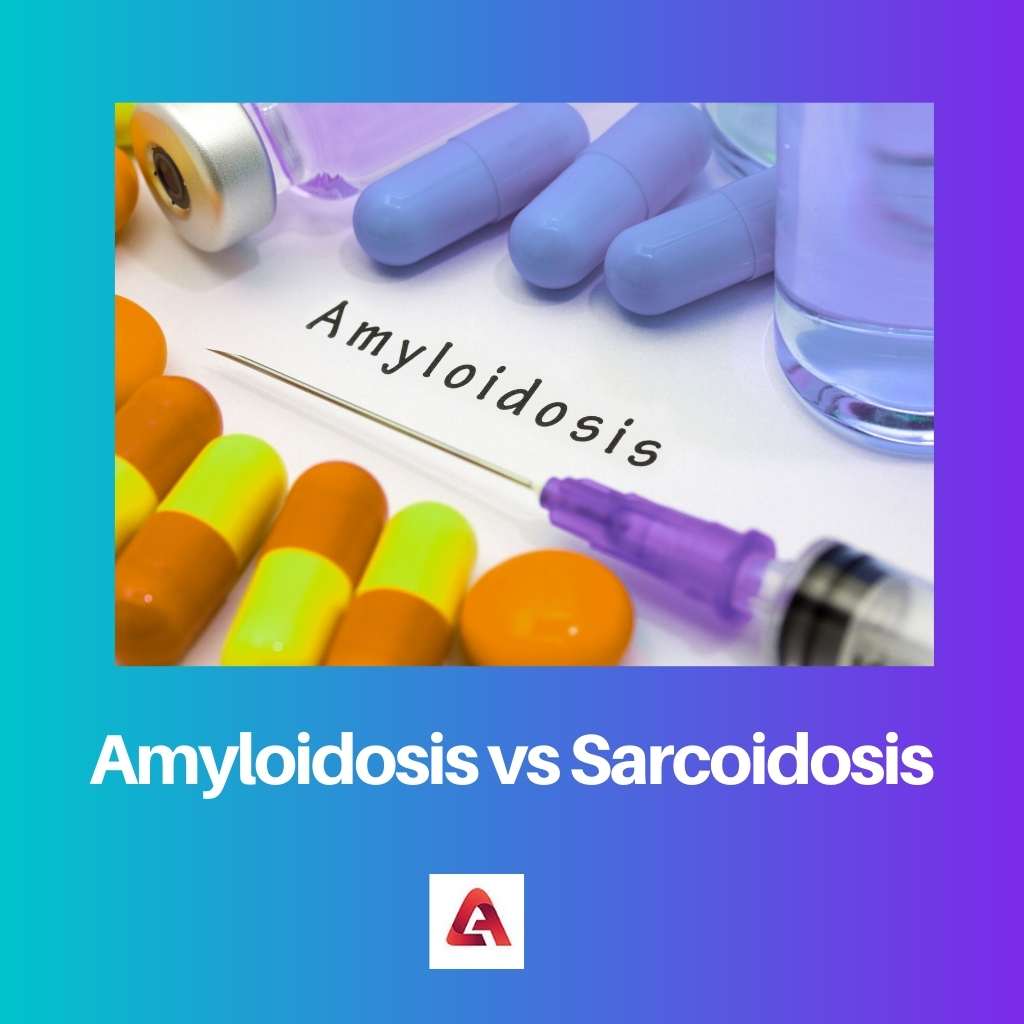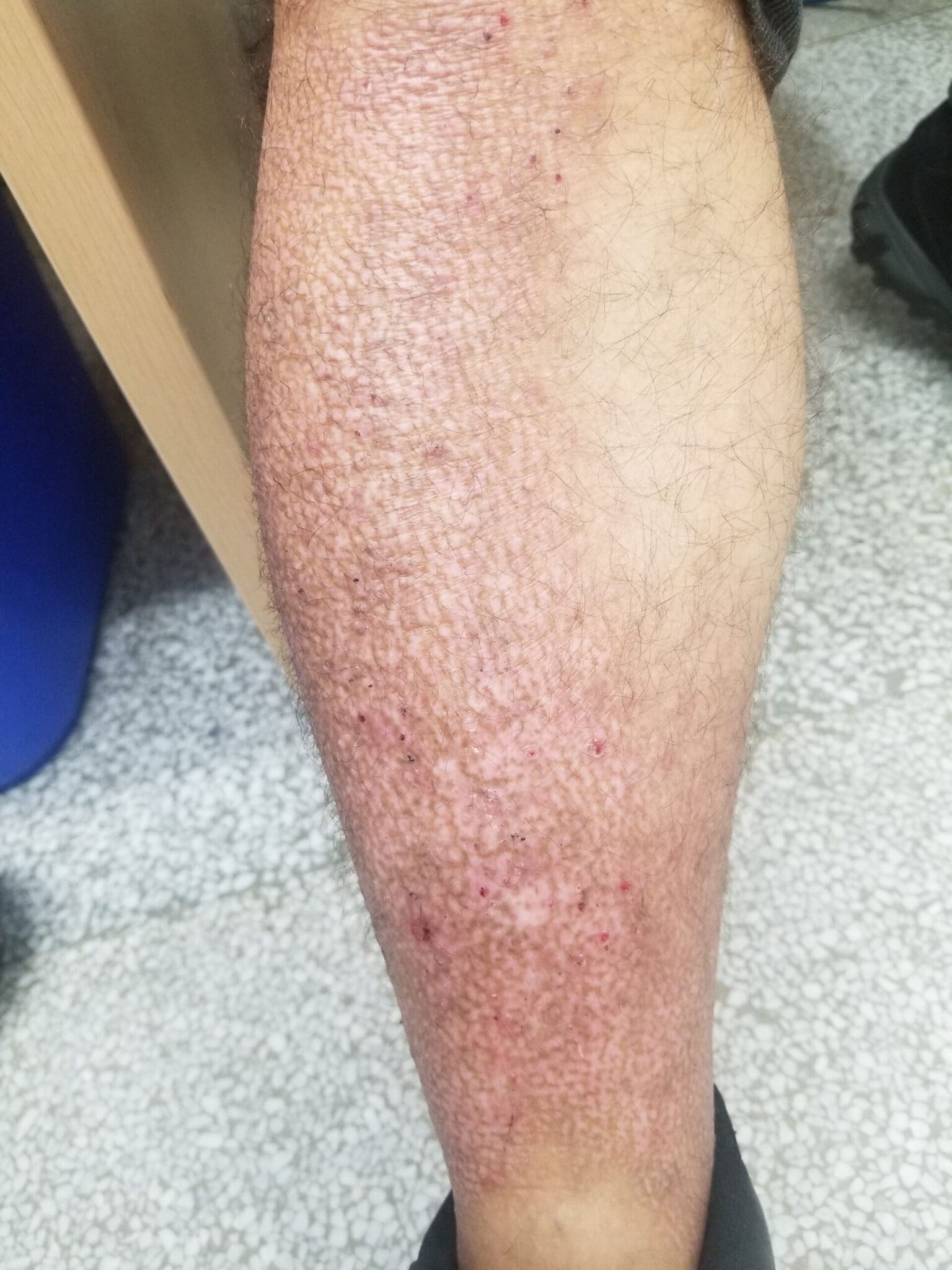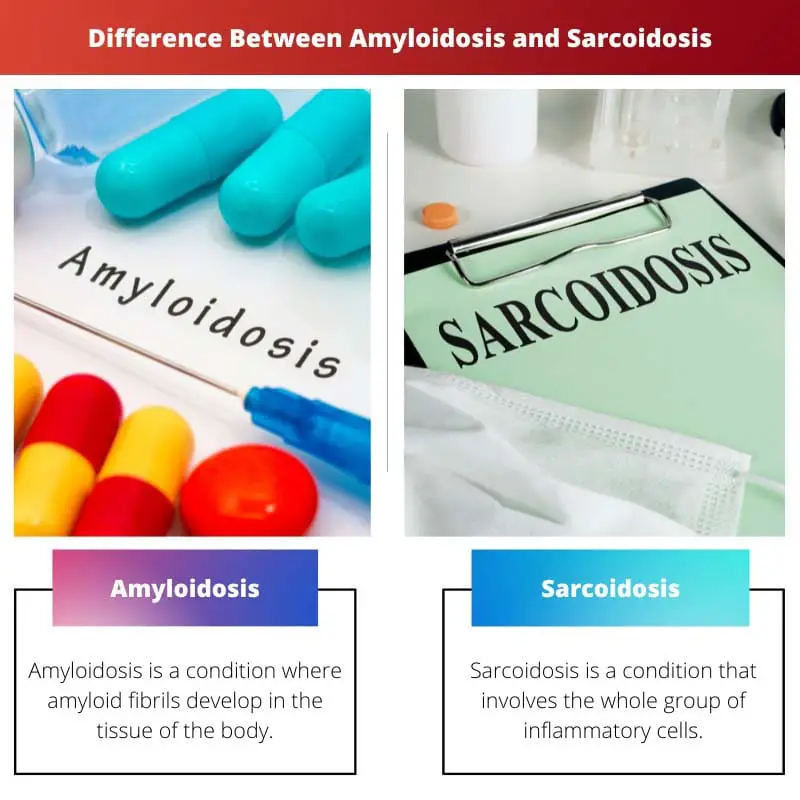The disease is an abnormal condition that happens in the human body. It affects the body negatively, causing harm. It affects the body in such a way that either the function or the structure of an organism gets imbalanced.
Diseases can be treated medically. It is referred to as a medical condition that is related to specific symptoms.
Most diseases are caused due to external things like a pathogen, virus, or bacteria that may enter the body and can cause pain, dysfunction, distress, social problems, or death.
Diseases not only affect us physically, but they can affect us mentally so much that the perspective of life gets changed. Amyloidosis and Sarcoidosis are the two types of abnormal diseases.
Key Takeaways
- Amyloidosis is a rare disease characterized by the buildup of abnormal proteins called amyloid in various organs. In contrast, sarcoidosis involves the formation of granulomas (clusters of immune cells) in different body parts.
- Both diseases can affect multiple organ systems, but amyloidosis is more likely to cause damage to the heart, kidneys, and nervous system. In contrast, sarcoidosis commonly affects the lungs and lymph nodes.
- Treatment for amyloidosis may include chemotherapy, stem cell transplantation, or supportive care, while sarcoidosis treatment involves anti-inflammatory medications or immunosuppressive drugs.
Amyloidosis vs Sarcoidosis
Amyloidosis is a group of diseases in which abnormal proteins called amyloid to accumulate in various tissues and organs of the body. It can be caused by genetic mutations or occur as a result of other conditions. Sarcoidosis is an inflammatory disease that affects various organs of the body.

Amyloidosis is a condition where amyloid fibrils develop in the tissue of the body. There are various symptoms related to this fatigue, shortness of breath, palpitations, peripheral oedema, weight loss, and feeling faint withstanding.
It happens to the old age group. It is a very rare condition. There are 36 types of Amyloidosis, each of which happens due to a specific protein. Proteins are misfolded or become irregular either due to environmental factors or due to a genetic condition.
Sarcoidosis is a condition that involves the whole group of inflammatory cells. These cells form lumps in the body called Granuloamata.
This disease begins in specific body organs, i.e., lymph nodes, skin, or lungs. But other organs need to get affected. When sarcoidosis happens in the lungs, the symptoms include wheezing, coughing, shortness of breath, or chest pain.
The causes of sarcoidosis are unknown. Although it is believed that it may happen due to genetic conditions or due to an infection.
Comparison Table
| Parameters of Comparison | Amyloidosis | Sarcoidosis |
|---|---|---|
| Speciality | Cardiology, Hematology, Endocrinology. | Immunology and Rheumatology. |
| Age | 55-65 years | 20-50 years old women |
| Causes | TB, leprosy, inherited mutations, ulcers, abdominal infections, and inflammation. | Unknown |
| Symptoms | Feeling tired, weight loss, swelling of the legs, shortness of breath, bleeding, feeling light-headed withstanding. | Depends upon the organ affected. |
| Treatment | Dialysis, Supportive care, organ transplantation. | Ibuprofen, prednisone, methotrexate |
What is Amyloidosis?
Amyloidosis forms based on amyloid accumulation. The most affected organ due to amyloidosis is the heart and kidneys. This disease happens due to the growth of the protein and if they are misfolding.
Proteins that are responsible for the amyloid deposits are found to be secreted proteins. There are 36 or 37 different types of amyloidosis. Out of which, only four of the proteins are cytosolic.
The diagnostic method that is followed during amyloidosis is tissue biopsy.
Symptoms of Amyloidosis include peripheral oedema, weight loss, shortness of breath, fatigue, palpitations, and feeling faint withstanding.
The four most common types of symptoms that happen in systemic amyloidosis are inflammation, dialysis-related, light chain, and hereditary and old age and familial amyloid polyneuropathy.
Amyloidosis is confirmed when there is an enlargement of the organs or protein that comes in urine. Often a diagnosis of amyloidosis can take time to detect.
Amyloidosis has a prevalence that in 1 lakh people about 30 can be confirmed with the most common types, i.e. ATTR, AA and AL. The prognosis of Amyloidosis depends upon the type and the part it is going to affect.
It can be improved with the treatment. Most treatment involved is to reduce the amount of protein. Since 1639, Amyloidosis has been discovered. If an untreated patient can leave from six months to four years depending upon the type.

What is Sarcoidosis?
Sarcoidosis is a collection of inflammatory cells that forms lumps around the body parts called Granulomata. The causes of Sarcoidosis is unknown.
Although it is believed that it may happen due to genetic conditions or some reaction that may trigger the infection. A person who is affected with Sarcoidosis is at greater risk if they are living with family members.
Diagnosis of sarcoidosis depends upon the symptoms and signs of the disease. Usually, a biopsy is done to confirm the disease.
In Sarcoidosis, any organ can be affected. Often mild or no symptoms can be seen. Sometimes sarcoidosis can resolve itself without any treatment.
Sometimes, it can take a long time or severe form. Some drugs are used that can improve inflammatory conditions like ibuprofen, methotrexate, chloroquine, or azathioprine etc.
The mortality rate of Sarcoidosis is 1 to 7%. The chances that it will affect the second time a patient is less than 5%.
Sarcoidosis was discovered in 1877 by one of the English doctors, Jonathan Hutchinson. When he discovered it, he called it the non-painful skin disease.
This disease is more common in women than men. It is seen that this disease happens mostly to the Scandinavian people. But in the rest of the world also it is found. In the USA, it is more common among black people than non-blacks.
Main Differences Between Amyloidosis and Sarcoidosis
- Amyloidosis belongs to the field of Cardiology, Hematology, Endocrinology. Sarcoidosis belongs to the field of Immunology and Rheumatology.
- Amyloidosis affects the age group between 55-65 years. Sarcoidosis affects the age group between 20-50 years. It is most6 common in women.
- Causes of Amyloidosis include TB, leprosy, inherited mutations, ulcers, abdominal infections, and inflammation. The causes of sarcoidosis are unknown.
- Symptoms of Amyloidosis include Feeling tired, weight loss, swelling of the legs, shortness of breath, bleeding, feeling light-headed withstanding. Symptoms of Sarcoidosis include depends upon the organ affected.
- Treatment of Amyloidosis includes Dialysis, supportive care, organ transplantation. Treatment of Sarcoidosis includes Ibuprofen, prednisone, methotrexate.


The information in the post is enlightening and informative, giving a clear understanding of Amyloidosis and Sarcoidosis.
I think the details are too much, and might not capture the attention of readers.
This post is truly helpful for those looking for information on Amyloidosis and Sarcoidosis. I’m impressed with the detailed comparison of the diseases.
The content about Amyloidosis and Sarcoidosis is very insightful. I was learning a lot from the post. I had no idea either of these diseases was so complex.
I don’t think so, too much say what is already known.
Amyloidosis and Sarcoidosis are certainly complicated diseases. The comparison and contrasts between them are interesting.
I don’t think the post is interesting. It’s too focused on details.
I agree, the post is not engaging enough.
The way the post explains the differences between Amyloidosis and Sarcoidosis is quite captivating. A very interesting read.
I would say the post is a bit too technical and dry.
The focus on Amyloidosis and Sarcoidosis is too detailed. This post is not going to be useful for a general audience.